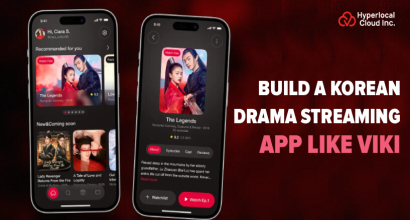Technology has become an indispensable part of our lives, and its rapid advancements have entirely transformed the fitness industry. Integrating emerging technologies has set the stage for an exciting and transformative future in fitness. Introducing fitness apps has revolutionized how we approach fitness, making it incredibly convenient for individuals to access virtual gyms and fitness centers from their homes. The revenue generation from fitness apps is $8.56 billion, and MyFitnessPal generates the maximum revenue among all fitness apps. Many entrepreneurs want to invest in this industry and create an app like MyFitnessPal.
Overview of MyFitnessPal
MyFitnessPal, a renowned health and fitness app, is a game-changer for users striving to achieve their fitness goals. This app provides food-tracking tools and assists customers in preparing diets according to their choice. MyFitnessPal also offers features that support weight loss, encourage exercise, and connect users to others on a similar health journey.
Benefits of Investing in an app like MyFitnessPal
Here are the main benefits of an app like MyFitnessPal:
Streamlining Operations: The health and app can streamline workflow by providing a centralized management platform for managing client information, scheduling appointments, and tracking progress.
Increase in Reach: A fitness app will allow you to reach and connect with many people, irrespective of their location. Also, offering them different offers and services can help you retain the old customers and attract new ones.
Analyzing Data Insights: The app allows you to analyze user data, provide insights into client behavior, and help identify areas for improvement.
Earning Loyalty and Retaining Clients: It can provide a way to engage personally with more clients and help you create an engaging environment. Additionally, it enables you to retain customers, increase customer satisfaction, and create more opportunities.
Types Of Fitness Apps in The Market
The market has a diverse range of fitness apps, each catering to different fitness needs. Here, we highlight some fitness app types:Workout Apps: The app helps users with exercise routines and plans for various fitness goals, such as weight loss, muscle building, and endurance training. Users can also include video demonstrations, timers, and progress-tracking features.
Nutrition and Diet Apps: The app helps users track their daily calorie intake, monitor their macronutrient ratios, and provide meal plans and recipes for a healthy diet.
Activity Tracking App: The activity and tracking app uses smartphone sensors and wearable devices to monitor daily activities, such as total steps taken, burned calories, and distance travelled.
Yoga and Meditation App: This app offers guided yoga, meditation, mindfulness exercises, and relaxing techniques to help reduce stress and promote mental well–being.
Personal Trainer Apps: This app provides personalized workout plans and coaching from certified personal trainers in person or through video chat.
Gamification: Gamification transforms health and fitness into interactive experiences with rewards for exercise completion, motivating users even during tough sessions.
Wellness and Health Apps: The app offers holistic approaches to health and wellness, including features like sleep tracking, stress management, and habit tracking.
Features of a Health and Fitness App like MyFitnessPal
Here is a list of significant features of the Health and Fitness App:
Personal Trainer App
Personalized Nutritional Plans: Helps personal trainers prepare personalized nutritional plans considering factors such as BMI, health condition, and medical history.
Fitness Charts: Helps prepare fitness plans based on an individual's physical condition, such as height, weight, health disorder, etc.
Calorie Counter: This feature allows trainers to quickly estimate the calories needed to maintain, lose, or gain weight.
Goal Setting: Fitness apps aim to assist users in setting and achieving daily goals.
Fitness Center App
Bookings For The Fitness Classes: The users can easily book fitness classes depending on their schedule and availability.
Membership Management: This feature helps fitness centers manage the membership plans of their loyal members from a uniform platform.
Progress Tracking: This tool helps fitness businesses track their customers' activities, such as their daily fitness routine, diet, or the achievements of daily tasks set by coaches.
Notifications: Enables businesses to notify their customers effectively about upcoming events, offers, and discounts.
Attendance Tracking: A feature integrated into the app enables fitness businesses to manage the attendance of their users and asses their progress from one place.
User App
Profile registration: Users must register their profiles on the app using personal information such as email ID, social media credentials, or phone number. Moreover, they can generate profiles based on their preferences, fitness levels, and goals.
Push Notifications: This feature helps you recommend new offers and discounts on the platform to your customers and notifies them about their upcoming goals and commitments.
Connecting Apps with Wearable Devices: The app is associated with external wearable devices, such as fitness trackers or smartwatches, through APIs (Application Programming Interfaces). This integration allows your customers to track their activities and exercise routines, as the data from these devices is automatically synced with the app.
Activity Tracker: Tracking activity is a crucial feature of an app like MyFitnessPal. This feature helps your customers track different physical activities, including walking, running, cycling, swimming, steps made, calories burned, miles run, etc., on any specific day.
Geolocation: This feature uses GPS or other location-tracking technologies to identify a user’s location. It also recommends that users attend nearby fitness activities like outdoor running routes, hiking trails, or local gyms or fitness studios.
Progress Report: Progress Tracking enables customers to track their fitness performance based on their daily physical activities. Also, it provides your customers with a graphical overview of their health status.
Admin Panel
User Management: The dashboard enables the admin to overview users, user progress, and engagement. They can also effectively manage user profiles and add new fitness coaches and businesses.
Inbox: The admin can interact with customers, learn their queries, and try to address all issues. This direct interaction enhances customer satisfaction.
Analytics: This feature allows administrators to analyze each client's performance and determine which fitness center generates the most revenue.
Payment Integration Method: Offers customers a secure payment integration method, such as credit cards, debit cards, or cash, to make payment.
Monetization Methods for Fitness Apps like MyFitnessPal
Here are some ways to generate revenue for your fitness app:
Subscription Fees: One of the best monetization ways for apps to earn money. Customers pay monthly, weekly, or quarterly payments to access exclusive content and premium features.
In-App Purchase: Allows to buy within a mobile app, including extra content and features.
Sponsorship: This model is another effective way to make money with an app. It involves promoting a sponsor’s brand, products, or services by placing product banners or directing users to their website in exchange for financial compensation.
Commission: Admin charges a commission from personal trainer and fitness center on every booking or transaction.
Steps to Develop a Fitness App like Myfitnesspal
Research Your Market
Before starting the development process, it’s crucial to understand the market needs and potential competition. Analyze the existing fitness apps to gain insights into their features, pricing models, and target audience. Identify the gaps in the market that your app can address, whether it's offering unique features or providing better customer service.
Choosing The Right Technology Stack
The technology stack is crucial to building a robust and scalable app like Myfitnesspal. Consider platform compatibility, scalability, security, and developer expertise when choosing your technology stack. Choose technologies that align with your project requirements and long-term goals.
UI/UX Design
The designers create an intuitive interface by making it engaging, visually attractive, and easy to navigate, providing an enjoyable experience for users.
Development
In this process, developers integrate all the necessary features using the right technology stack to ensure the smooth functioning of fitness apps. Some of the popular programming languages we use Node. Js, React, Flutter, and Javascript.
Testing And Quality Assurance
Ensuring your app works reliably across various devices and scenarios is essential. Conduct thorough tests for both backend and frontend components, including functional testing, usability testing, performance testing, or security testing. Also, identify and address bugs, glitches, or usability issues before launching your app to the public.
Deployment
When your application is tested for technical errors and flaws, it is ready for deployment. In the deployment process, you must deploy the app on the server and determine whether it meets the security standards defined for data leakage.
Launching and marketing your app is essential for attracting the public and creating buzz about your app in the market. You can use various techniques to reach your target audiences, such as social media, search engine optimization, and influencer partnerships to reach your target audience.
Monitoring and Maintenance
After launching your health and fitness app, ongoing monitoring and maintenance are essential to ensure optimal performance and user satisfaction. Monitor key metrics such as app downloads, active users, retention rates, and customer feedback to identify improvement areas and promptly address any issues.
Cost Of Development of Health and Fitness Apps like Myfitnesspal
The cost of developing health and fitness is between $20,000 to $50,000. Here are some factors that directly affect the cost of the development of your app:
Complexity of the App: The complexity and integration of different features into your app can affect its price. Adding advanced features like AI recommendations and real-time tracking requires more time and expertise. On the other hand, adding basic features to the app costs less than integrating advanced and complex features.
Choice of Platform: Apps can be developed for multiple platforms, including iOS, Android, and the web. Each platform has unique requirements and coding languages. Ensuring compatibility across different devices, screen sizes, and operating systems adds to the development workload and cost.
Features and Functionalities: The more features an app offers, the more time and effort it takes to implement and test each. Features like user authentication, geolocation, social media integration, and in-app purchases all contribute to the rise in app cost.
User Interface and Design: An intuitive and visually appealing user interface is crucial for any app’s success. Designing a user-friendly and aesthetically pleasing interface involves UI/UX experts who understand user behaviour. Their expertise adds to the development expenses.
Third-Party Integration: Integrating third-party services like payment gateways or analytical tools can affect the cost of developing the app.
Security of the Platform: Implementing measures to secure data, transactions, and sensitive information is crucial. These include encryption protocols, stable authentication mechanisms, and compliance with data safety regulations like GDPR and HIPAA. Therefore, ensuring the app's security adds additional fees to the development of the app.



